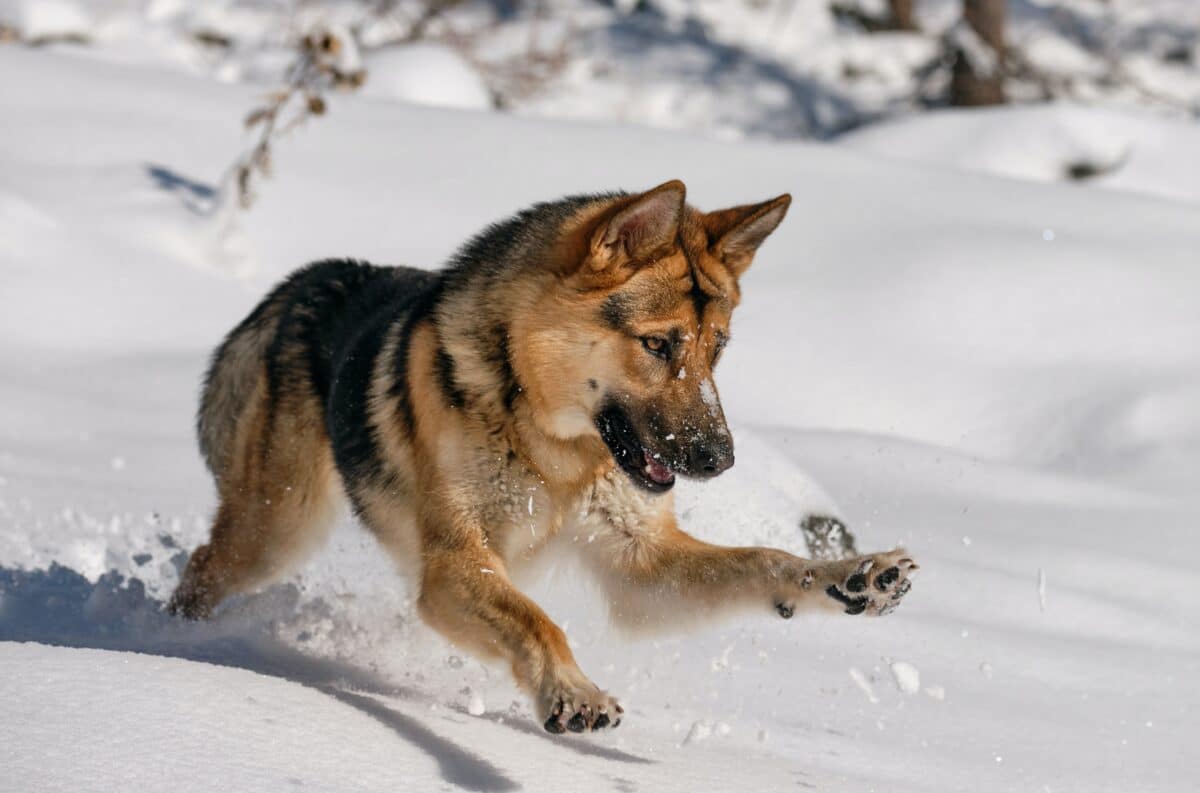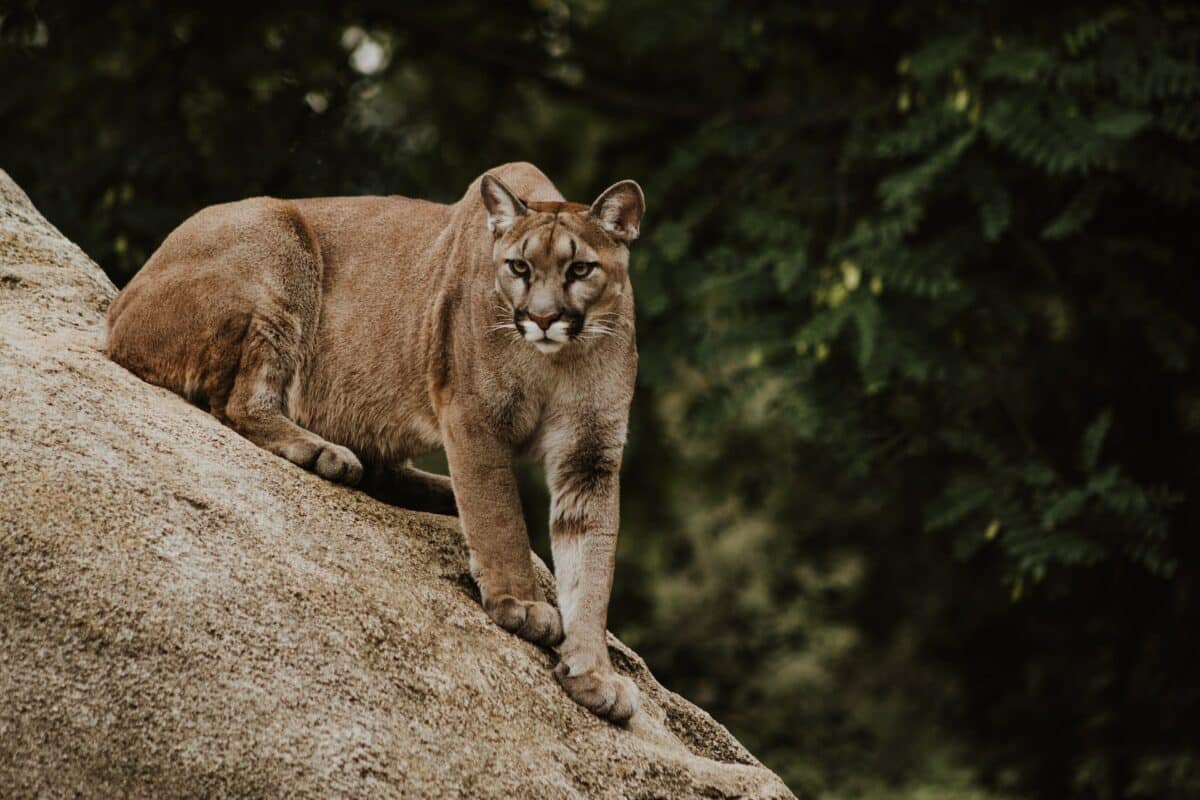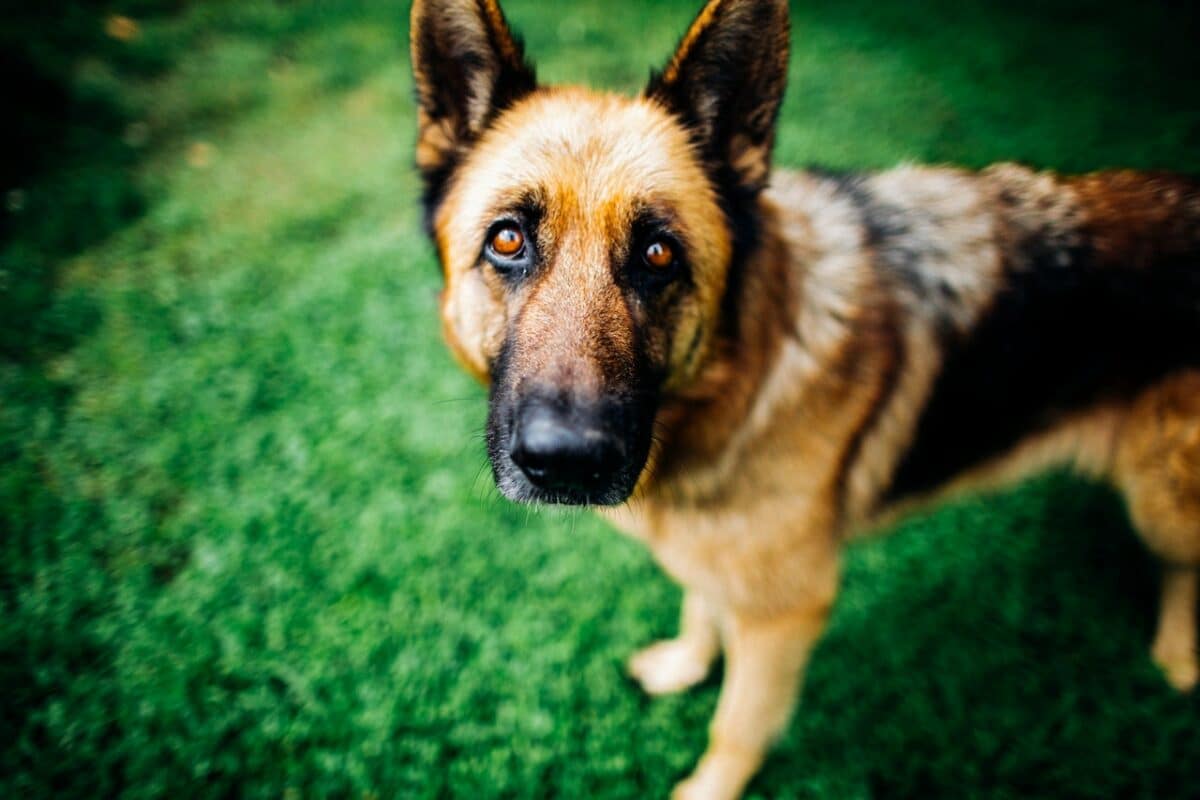You may think Puma vs. German Shepherd is a pretty odd comparison because I do. Let’s find out more together.
Both of these animals have distinct characteristics and advantages, but how do they compare?
Weighing in both animals’ characteristics, let’s look at the comparable aspects of the Pumas and German Shepherds to help you determine which creatures’ advantages outweighs the other.

Want to jump ahead? Click below
Comparison Table
| Puma | German Shepherd | |
|---|---|---|
| Species Classification | Felidae | Canidae |
| Size | 6-9 ft in length, 115-220 lbs in weight | 22-26 in height, 50-90 lbs in weight |
| Habitat | Wild, found in many parts of the world | Domesticated, kept as pets or working dogs |
| Diet | Carnivorous, primarily meat-based | Omnivorous, meat, and plant-based diet |
| Social Behavior | Solitary, territorial | Social, pack-oriented |
| Intelligence | Highly intelligent | Highly intelligent, trainable |
| Physical Abilities | Powerful and agile, with sharp claws and teeth | Strong, athletic, and good at tasks such as tracking and herding |
| Lifespan | 8-13 years in the wild, up to 20 years in captivity | 9-13 years on average |
| Threat to Humans | Potentially dangerous, can attack if threatened or hungry | Generally safe and protective of humans, may attack if provoked or trained for aggression |
| Conservation Status | Near threatened or vulnerable, depending on species | Not threatened, common in many parts of the world |
Puma Vs. German Shepherd: Why Comparing The Two Animals Is Important?

Deciding on which animal’s advantages outweigh the other is an intriguing decision. Comparing Pumas and German Shepherds is interesting because it allows you to choose which has more pros or cons.
While both species have unique features and benefits, weighing their temperaments, health, exercise requirements, and overall size and appearance before making your final decision is essential. Ultimately, finding the one that will come up on top.
Puma Characteristics

Puma, cougars, or mountain lions are majestic creatures that thrive in North and South America.
Appearance
Pumas are muscular, athletic animals. Adult male Pumas can weigh up to 220 pounds, while females weigh around 140 pounds. They have slender, agile built, and strong legs with powerful paws that enable them to pounce on prey. Pumas possess a dense coat of fur ranging in hue from reddish-brown to gray. Their belly, chest, and the inside of their legs are usually paler, and some Pumas have black spots on their coats.
Behavior
Pumas have a solitary nature, and they often hunt alone. They stalk prey, overwhelming them with quick bursts of speed with a powerful pounce. Pumas are generally most active at dawn and dusk. They prefer remote, mountainous areas but can be observed in canyons, foothills, and dense forests.
Temperament
While Pumas are not domesticated animals, they can adapt to captivity. They are incredibly loyal to their families and can become attached to humans, though their independence means they remain fiercely independent. As carnivorous animals, pumas require a diet primarily composed of meat. They can exhibit aggressive and unpredictable behavior, mainly when confined or threatened.
Training
Pumas are not easily trainable due to their independent personality and predatory instincts. They are commonly trained to be comfortable around humans, but it is not uncommon for Pumas to attack their handlers, especially if they feel threatened or uncomfortable. Even with the best handlers, Pumas require specialized training, making them unsuitable for the average pet owner.
Exercise And Diet
Pumas require a lot of exercise and a diet primarily consisting of protein. In the wild, they hunt and roam over vast spaces that provide them with opportunities to run and climb. In captivity, Pumas need a large, secure enclosure or an expansive outdoor area to simulate the wild. Their diet should include raw meat, with variations such as beef, pork, and game meat.
German Shepherds Characteristics: Is the German Shepherd Right Pet for You?

German Shepherds are known for their intelligence, courage, and work ethic, making them perfect for various activities, from police and military work to family companionship. Below, we will take a closer look at some of the defining characteristics of this breed:
Appearance
German Shepherds are a medium to large-sized breed, with males typically weighing between 65 and 90 pounds and females weighing between 50 and 70 pounds. Pumas have a muscular physique, lengthy torso, and well-proportioned, sturdy heads. Their thick coat comes in various colors, including black, tan, ebony, and blue.
Behavior
One of the defining characteristics of the German Shepherd is their herding ability. They are natural working dogs, and their instincts make them great at rounding up livestock and protecting their territory. German Shepherds are known for their social and friendly temperament, making them ideal family pets. They are fiercely loyal and protective and will go to great lengths to ensure the safety of their loved ones.
Temperament
German Shepherds possess an instinct to safeguard and protect their family, which can lead to some apprehension around strangers. Nevertheless, German Shepherds can become friendly and affectionate companions with appropriate socialization and training.
Training
Thanks to their intelligence and eager-to-please nature, German Shepherds are a highly trainable breed. They respond positively to techniques based on positive reinforcement, such as rewarding good behavior with treats and affection. Common commands that German Shepherds can easily learn include sit, stay, come, heel, and down.
Exercise And Diet Requirements
German Shepherds are a very active breed and require daily exercise to prevent boredom and restlessness. They can be prone to weight gain if not given enough exercise, so it’s important to maintain a healthy diet and exercise regimen.
A balanced diet for a German Shepherd includes high-quality protein sources, vegetables, and grains. As with any dog, monitoring their weight and adjusting their diet is essential.
Puma Vs. German Shepherd – Comparative Analysis

When it comes to hosting a four-legged friend in your house, Pumas and German Shepherds are two of the most popular and commendable breed options for you to consider. However, it can be a daunting task to decide which breed can be the best fit for your requirements.
Physical Abilities: Speed, Strength, And Endurance
Pumas, also known as mountain lions, are a type of large cat that can run up to 50 miles per hour, which makes them quite competitive in terms of speed when compared to German Shepherds.
However, German Shepherds could effortlessly outpace Pumas when it comes to strength and endurance. German Shepherds are well-built dogs that can run 30 miles per hour and have a higher jumping ability, making them ideal for active families that love outdoor activities.
Behavioral Tendencies: Hunting Vs. Herding
Pumas have strong hunting instincts and are fiercely independent creatures that prefer being alone. They are commonly known for chasing down large prey, such as deer or elk, in the wild. In contrast, German Shepherds are well-known for their protective and herding instincts. They are often used as working dogs in law enforcement or the military because of their loyal, brave, and protective nature toward their owners.
Learn more about how Staying Safe Around Wild Cats.
Temperament Traits: Independence Vs. Sociability
As mentioned earlier, Pumas are known for their fiercely independent temperament. They prefer being alone and are generally not suitable pets for a family with small children. On the other hand, German Shepherds are social creatures that require love, affection, and attention from their owners. They are incredibly loyal and protective of their family members and are an excellent choice for those looking for a companion dog.
Trainability: Ease Of Training Vs. Difficulty Level
German Shepherds are well-known for their high level of intelligence and capability to train quickly. They are obedient and usually respond well to commands, making them one of the easiest dog breeds to train. On the other hand, Pumas cannot be taught like dogs, as they are wild animals and require different training techniques.
Exercise And Dietary Requirements: Similarities And Differences
Both Pumas and German Shepherds have similar exercise requirements that demand a lot of physical activity. However, Pumas have a more varied diet as carnivores, while German Shepherds have a specific diet that requires a balance of protein, carbohydrates, and fats. It is recommended to feed German Shepherds a diet of high-quality dog food specifically designed for their nutritional needs.
Key Points

| Comparing Pumas and German Shepherds is important because it allows you to decide which breed best suits you and your family’s lifestyle. |
| Pumas require a lot of exercise and a diet primarily consisting of protein. In the wild, they hunt and roam over vast spaces that provide them with opportunities to run and climb. |
| German Shepherds are fiercely loyal and protective and will go to great lengths to ensure the safety of their loved ones. |
| Pumas are often used as working dogs in law enforcement or the military because of their loyal, brave, and protective nature toward their owners. |
| German Shepherds are well-known for their high level of intelligence and capability to train quickly. |
Wrapping Up with Puma vs. Rhino
Pumas and German Shepherds are fascinating breeds with distinct strengths and characteristics. While Pumas are recognized for their speed, power, and agility, German Shepherds are known for their loyalty, intelligence, and protective instincts.
The choice between Pumas and German Shepherds ultimately depends on various factors, such as living conditions, lifestyle, and personal preferences. So, before bringing home a new furry friend, research and understand each breed’s specific needs and requirements to ensure a happy and healthy coexistence.
Thanks for following along with me! I hope you enjoyed reading about the pros and cons of two very different terrestrial animals. Next are Who Would Win In A Faceoff?, Lion and the Eagle, and Gorilla vs. Cape Buffalo.
- Bald Eagle Family Expand Their Nest In California - April 24, 2024
- Firefighter Saves Abandoned Kittens Found Cuddling In Hoses - April 24, 2024
- Dolphins Get High Playing Catch With A Pufferfish - April 24, 2024


